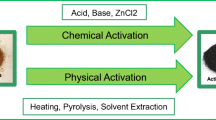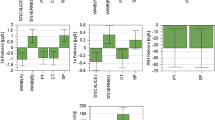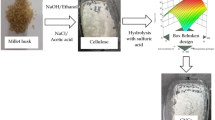Abstract
This study investigates the applicability of decanter centrifuges for high efficient separation of valuable proteins from whey. Thus, two different types of protein aggregates, α-lactalbumin (α-la) and β-lactoglobulin (β-lg), were produced by means of selective thermal aggregation. The two aggregate suspensions were investigated for their particle characteristics, sedimentation, and consolidation behavior, and were finally separated in a lab-scale decanter. They showed severe differences in particle size distribution, particle shape, and in the underlying molecular binding mechanisms, all affecting their separability. In scale-down experiments, the non-covalently stabilized α-la aggregates presented sedimentation enhancing flocculation, and a high compressibility of the cake. However, the beneficial sedimentation effects were not observed in the decanter, as the centrifugal forces resulted in particle breakdown. Moreover, the high adhesiveness of sludge-like sediment impeded the discharge. Under best investigated conditions, a clarification around 70% of the supernatant and a dry solid content of 25% in sediment was achieved. Contrary to that, the β-lg aggregates, stabilized by disulfide bonds, were rigid aggregates comprising a median size of 109 μm with irregular shapes. They presented low compressibility in scale-down testing but were discharged as a free-flowing powder from the decanter. The sediment dryness of maximal 40% was attributed to enclosed liquid through thermal aggregation process, which is also reflected in the low particle density. This study demonstrates the successful application of a decanter for the separation of whey proteins and contributes to the understanding of aggregate separability by means of continuous centrifuges.












Similar content being viewed by others
References
Abd El-Salam, M. H., El-Shibiny, S., & Salem, A. (2009). Factors affecting the functional properties of whey protein products: A review. Food Reviews International, 25(3), 251–270.
Bargieł, M., & Tory, E. M. (2013). Extension of the Richardson–Zaki equation to suspensions of multisized irregular particles. International Journal of Mineral Processing, 120, 22–25.
Bell, D. J., & Dunnill, P. (1982). The influence of precipitation reactor configuration on the centrifugal recovery of isoelectric soya protein precipitate. Biotechnology and Bioengineering, 24(11), 2319–2336.
Booij, L., Merens, W., Markus, C. R., & van der Does, A. W. (2006). Diet rich in α-lactalbumin improves memory in unmedicated recovered depressed patients and matched controls. Journal of Psychopharmacology, 20(4), 526–535.
Bramaud, C., Aimar, P., & Daufin, G. (1995). Thermal isoelectric precipitation of α-lactalbumin from a whey protein concentrate: Influence of protein–calcium complexation. Biotechnology and Bioengineering, 47(2), 121–130.
Bramaud, C., Aimar, P., & Daufin, G. (1997a). Optimisation of a whey protein fractionation process based on the selective precipitation of α-lactalbumin. Le Lait, 77(3), 411–423.
Bramaud, C., Aimar, P., & Daufin, G. (1997b). Whey protein fractionation: Isoelectric precipitation of α-lactalbumin under gentle heat treatment. Biotechnology and Bioengineering, 56(4), 391–397.
Buscall, R., & White, L. R. (1987). The consolidation of concentrated suspensions. Part 1.—The theory of sedimentation. Journal of the Chemical Society, Faraday Transactions 1: Physical Chemistry in Condensed Phases, 83(3), 873–891.
Chatterton, D. E., Smithers, G., Roupas, P., & Brodkorb, A. (2006). Bioactivity of β-lactoglobulin and α-lactalbumin—Technological implications for processing. International Dairy Journal, 16(11), 1229–1240.
Coe, H. S., & Clevenger, C. H. (1916). Methods for determining the capacities of slime-settling tanks. Transactions of the American Institute of Mining and Metallurgical Engineers, 60, 356–384.
Croguennec, T., O’Kennedy, B. T., & Mehra, R. (2004). Heat-induced denaturation/aggregation of β-lactoglobulin A and B: Kinetics of the first intermediates formed. International Dairy Journal, 14(5), 399–409.
Curvers, D., Saveyn, H., Scales, P. J., & Van der Meeren, P. (2009). A centrifugation method for the assessment of low pressure compressibility of particulate suspensions. Chemical Engineering Journal, 148(2–3), 405–413.
Dannenberg, F., & Kessler, H.-G. (1988). Reaction kinetics of the denaturation of whey proteins in milk. Journal of Food Science, 53(1), 258–263.
De Wit, J. N. (2009). Thermal behaviour of bovine β-lactoglobulin at temperatures up to 150 C. A review. Trends in Food Science & Technology, 20(1), 27–34.
Dombrowski, J., Gschwendtner, M., & Kulozik, U. (2017). Evaluation of structural characteristics determining surface and foaming properties of β-lactoglobulin aggregates. Colloids and Surfaces A: Physicochemical and Engineering Aspects, 516, 286–295.
Erabit, N., Flick, D., & Alvarez, G. (2014). Formation of β-lactoglobulin aggregates during thermomechanical treatments under controlled shear and temperature conditions. Journal of Food Engineering, 120, 57–68.
Fernández, A., Menéndez, V., & Riera, F. A. (2012). α-Lactalbumin solubilisation from a precipitated whey protein concentrates fraction: pH and calcium concentration effects. International Journal of Food Science & Technology, 47(3), 467–474.
Friedman, H. H., Whitney, J. E., & Szczesniak, A. S. (1963). The texturometer—A new instrument for objective texture measurement. Journal of Food Science, 28(4), 390–396.
Griffin, W. G., Griffin, M. C. A., Martin, S. R., & Price, J. (1993). Molecular basis of thermal aggregation of bovine β-lactoglobulin A. Journal of the Chemical Society, Faraday Transactions, 89(18), 3395–3405.
Håkansson, A., Svensson, M., Mossberg, A., Sabharwal, H., Linse, S., Lazou, I., LoÈnnerdal, B., & Svanborg, C. (2000). A folding variant of α-lactalbumin with bactericidal activity against Streptococcus pneumoniae. Molecular Microbiology, 35(3), 589–600.
Heine, W., Radke, M., Wutzke, K. D., Peters, E., & Kundt, G. (1996). α-Lactalbumin-enriched low-protein infant formulas: A comparison to breast milk feeding. Acta Paediatrica, 85(9), 1024–1028.
Hernández-Ledesma, B., Amigo, L., Recio, I., & Bartolomé, B. (2007). ACE-inhibitory and radical-scavenging activity of peptides derived from β-lactoglobulin f (19−25). Interactions with ascorbic acid. Journal of Agricultural and Food Chemistry, 55(9), 3392–3397.
Hernández-Ledesma, B., Recio, I., & Amigo, L. (2008). β-Lactoglobulin as source of bioactive peptides. Amino Acids, 35(2), 257–265.
Hillier, R. M., & Lyster, R. L. J. (1979). Whey protein denaturation in heated milk and cheese whey. Journal of Dairy Research, 46(1), 95–102.
Kynch, G. J. (1952). A theory of sedimentation. Transactions of the Faraday Society, 48, 166–176.
Leeb, E., Haller, N., & Kulozik, U. (2018). Effect of pH on the reaction mechanism of thermal denaturation and aggregation of bovine β-lactoglobulin. International Dairy Journal, 78, 103–111.
Lerche, D., & Sobisch, T. (2007). Consolidation of concentrated dispersions of nano- and microparticles determined by analytical centrifugation. Powder Technology, 174(1), 46–49.
Lien, E. L. (2003). Infant formulas with increased concentrations of α-lactalbumin. The American Journal of Clinical Nutrition, 77(6), 1555S–1558S.
Loginov, M., Lebovka, N., & Vorobiev, E. (2014). Multistage centrifugation method for determination of filtration and consolidation properties of mineral and biological suspensions using the analytical photocentrifuge. Chemical Engineering Science, 107 277-289.
Loginov, M., Zierau, A., Kavianpour, D., Lerche, D., Vorobiev, E., Gésan-Guiziou, G., Mahnic-Kalamiza, S., & Sobisch, T. (2017). Multistep centrifugal consolidation method for characterization of filterability of aggregated concentrated suspensions. Separation and Purification Technology, 183, 304–317.
Lucena, E. M., Alvarez, S., Menéndez, C., Riera, F. A., & Alvarez, R. (2006). Beta-lactoglobulin removal from whey protein concentrates. Separation and Purification Technology, 52(2), 310–316.
Markus, C. R., Jonkman, L. M., Lammers, J. H., Deutz, N. E. P., Messer, M. H., & Rigtering, N. (2005). Evening intake of α-lactalbumin increases plasma tryptophan availability and improves morning alertness and brain measures of attention. The American Journal of Clinical Nutrition, 81(5), 1026–1033.
Maubois, J. L., Pierre, A., Fauquant, J., & Piot, M. (1987). Industrial fractionation of main whey proteins. Schaerbeek: International Dairy Federation.
Maybury, J. P., Hoare, M., & Dunnill, P. (2000). The use of laboratory centrifugation studies to predict performance of industrial machines: Studies of shear-insensitive and shear-sensitive materials. Biotechnology and Bioengineering, 67(3), 265–273.
Mehra, R., & Kelly, P. M. (2004). Whey protein fractionation using cascade membrane filtration. Bulletin-International Dairy Federation, (389), 40–44.
Munro, P. A., & Van Til, H. J. (1988). Centrifugal dewatering of acid casein curd: Effect of casein manufacturing and centrifugation variables on curd compression in a laboratory centrifuge. Biotechnology and Bioengineering, 32(9), 1153–1157.
Neyestani, T. R., Djalali, M., & Pezeshki, M. (2003). Isolation of α-lactalbumin, β-lactoglobulin, and bovine serum albumin from cow’s milk using gel filtration and anion-exchange chromatography including evaluation of their antigenicity. Protein Expression and Purification, 29(2), 202–208.
Nicolai, T., Britten, M., & Schmitt, C. (2011). β-Lactoglobulin and WPI aggregates: Formation, structure and applications. Food Hydrocolloids, 25(8), 1945–1962.
Outinen, M., Tossavainen, O., & Syväoja, E.-L. (1996). Chromatographic fractionation of α-lactalbumin and β-lactoglobulin with polystyrenic strongly basic anion exchange resins. LWT - Food Science and Technology, 29(4), 340–343.
Pearce, R. J. (1983). Thermal separation of [beta]-lactoglobulin and [alpha]-lactalbumin in bovine cheddar cheese whey. Australian Journal of Dairy Technology, 38(4), 144.
Pearce, R. J. (1991). Applications for cheese whey protein fractions. Food Research Quarterly, 51, 74–85.
Pellegrini, A., Thomas, U., Bramaz, N., Hunziker, P., & von Fellenberg, R. (1999). Isolation and identification of three bactericidal domains in the bovine α-lactalbumin molecule. Biochimica et Biophysica Acta (BBA)-General Subjects, 1426(3), 439–448.
Permyakov, E. A., & Berliner, L. J. (2000). α-Lactalbumin: Structure and function. FEBS Letters, 473(3), 269–274.
Rammer, P., Groth-Pedersen, L., Kirkegaard, T., Daugaard, M., Rytter, A., Szyniarowski, P., Høyer-Hansen, M., Povlsen, L. K., Nylandsted, J., & Larsen, J. E. (2010). BAMLET activates a lysosomal cell death program in cancer cells. Molecular Cancer Therapeutics, 9(1), 24–32.
Records, A., & Sutherland, K. (2001). Decanter centrifuge handbook. Elsevier.
Richardson, J. F., & Zaki, W. N. (1954). The sedimentation of a suspension of uniform spheres under conditions of viscous flow. Chemical Engineering Science, 3(2), 65–73.
Roefs, S. P. F. M., & de Kruif, K. G. (1994). A model for the denaturation and aggregation of β-lactoglobulin. European Journal of Biochemistry, 226(3), 883–889.
Schultz, C. P. (2000). Illuminating folding intermediates. Nature Structural and Molecular Biology, 7(1), 7–10.
Sobisch, T., & Lerche, D. (2000). Application of a new separation analyzer for the characterization of dispersions stabilized with clay derivatives. Colloid and Polymer Science, 278(4), 369–374.
Stahl, W. H. (2004). Fest-Flüssig-Trennung. 2, Industrie-Zentrifugen. Maschinen-& Verfahrenstechnik: DrM Press.
Tolkach, A., & Kulozik, U. (2008). Kinetic modeling of the thermal denaturation of bovine alpha-lactalbumin in a acidic pH-region and in the presence of a calcium complexing agent. Chemie Ingenieur Technik, 80(8), 1165–1173.
Tolkach, A., Steinle, S., & Kulozik, U. (2005). Optimization of thermal pretreatment conditions for the separation of native α-lactalbumin from whey protein concentrates by means of selective denaturation of β-lactoglobulin. Journal of Food Science, 70(9), E557–E566.
Toro-Sierra, J., Tolkach, A., & Kulozik, U. (2013). Fractionation of α-lactalbumin and β-lactoglobulin from whey protein isolate using selective thermal aggregation, an optimized membrane separation procedure and resolubilization techniques at pilot plant scale. Food and Bioprocess Technology, 6(4), 1032–1043.
Trabulsi, J., Capeding, R., Lebumfacil, J., Ramanujam, K., Feng, P., McSweeney, S., Harris, B., & DeRusso, P. (2011). Effect of an α-lactalbumin-enriched infant formula with lower protein on growth. European Journal of Clinical Nutrition, 65(2), 167–174.
Turhan, K. N., & Etzel, M. R. (2004). Whey protein isolate and α-lactalbumin recovery from lactic acid whey using cation-exchange chromatography. Journal of Food Science, 69(2), fep66–fep70.
Usher, S. P., Studer, L. J., Wall, R. C., & Scales, P. J. (2013). Characterisation of dewaterability from equilibrium and transient centrifugation test data. Chemical Engineering Science, 93, 277–291.
Wakeman, R. J. (2007). Separation technologies for sludge dewatering. Journal of Hazardous Materials, 144(3), 614–619.
Acknowledgements
We gratefully thank Annette Brümmer-Rolf and Andreas Greßlinger for experimental support and fruitful discussions.
This IGF project of the FEI was supported via AiF (AiF 18126 N) within the program for promoting the Industrial Collective Research (IGF) of the German Ministry of Economic Affairs and Energy (BMWi), based on a resolution of the German Parliament.
Author information
Authors and Affiliations
Corresponding author
Additional information
Publisher’s Note
Springer Nature remains neutral with regard to jurisdictional claims in published maps and institutional affiliations.
Rights and permissions
About this article
Cite this article
Haller, N., Kulozik, U. Separation of Whey Protein Aggregates by Means of Continuous Centrifugation. Food Bioprocess Technol 12, 1052–1067 (2019). https://doi.org/10.1007/s11947-019-02275-1
Received:
Accepted:
Published:
Issue Date:
DOI: https://doi.org/10.1007/s11947-019-02275-1




